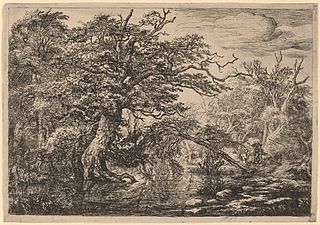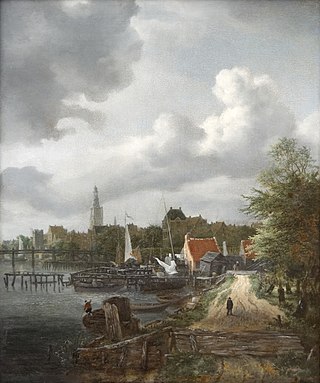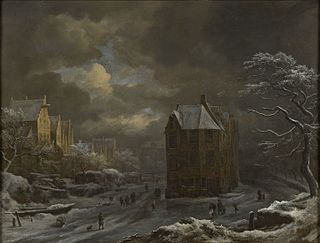
Wijk bij Duurstede is a municipality and a city in the central Netherlands.

Jacob Isaackszoon van Ruisdael was a Dutch painter, draughtsman, and etcher. He is generally considered the pre-eminent landscape painter of the Dutch Golden Age, a period of great wealth and cultural achievement when Dutch painting became highly popular.

The Ray of Light, also known as Le Coup de Soleil, is an oil on canvas painting by the Dutch painter Jacob van Ruisdael. It is an example of Dutch Golden Age painting and is now in the collection of the Louvre Museum.

Two Watermills and an Open Sluice near Singraven is an oil on canvas painting by the Dutch landscape painter Jacob van Ruisdael. It is an example of Dutch Golden Age painting and is now in the collection of the National Gallery.

Landscape with Waterfall is an oil on canvas painting by the Dutch landscape painter Jacob van Ruisdael. It is an example of Dutch Golden Age painting and is now in the collection of the Amsterdam Museum, on loan to the Rijksmuseum.

Landscape with a Cottage and Trees (1646) is an oil-on-panel painting by the Dutch Golden Age painter Jacob van Ruisdael. It is in the collection of the Kunsthalle in Hamburg.

Bentheim Castle (1653) is an oil on canvas painting by the Dutch Golden Age painter Jacob van Ruisdael. It is in the collection of the National Gallery of Ireland in Dublin.

Wooded Dunes, also known as Dune Landscape, Peasant Cottage in a Landscape, Wooded Dunes and Cottage in a Grove is a 1646 oil-on-panel painting by the Dutch Golden Age painter Jacob van Ruisdael. It is in the collection of the Hermitage Museum in St. Petersburg.

Forest Marsh with Travellers on a Bank (1640s-1650s), also known as The Travellers, is an etching by the Dutch Golden Age artist Jacob van Ruisdael. A few copies are known, including those in the collections of the British Museum, Metropolitan Museum of Art in New York, the Rijksprentenkabinet of the Rijksmuseum Amsterdam, and Museum Boymans-van Beuningen in Rotterdam.

Grainfield at the Edge of a Wood, also known as The Cornfield, is a 1648 etching by the Dutch Golden Age artist Jacob van Ruisdael. There are five versions known about the etching. The first state is at the British Museum in London. The second state, in which a few lines in the sky have been added, is at the Rijksmuseum in Amsterdam. On the later states "JvRuysdael" has been added by another hand than Jacob's.

Storm Off a Sea Coast, also known as The Breakwater, is a 1670 oil on canvas painting by the Dutch Golden Age painter Jacob van Ruisdael. It is in the collection of the Louvre in Paris.

View of the Binnenamstel at Amsterdam is a 17th-century oil on canvas painting by the Dutch Golden Age painter Jacob van Ruisdael. It is in the collection of the Museum of Fine Arts in Budapest.

Panoramic view of the Amstel looking toward Amsterdam is a 17th-century oil on canvas painting by the Dutch Golden Age painter Jacob van Ruisdael. It is in the collection of the Fitzwilliam Museum in Cambridge.

Winter View of the Hekelveld in Amsterdam is a 17th-century oil on canvas painting by the Dutch Golden Age painter Jacob van Ruisdael. It is in a private collection in Scotland.

Evening Landscape: A Windmill by a Stream is a 17th-century oil on canvas painting by the Dutch Golden Age painter Jacob van Ruisdael. It is in the collection of Queen Elizabeth II, on display at the Queen's Gallery at Buckingham Palace. It was acquired by King George IV in 1810.

A Thatch-Roofed House with a Water Mill, also known as Water Mill near a Farm, is a 17th-century oil on panel painting by the Dutch Golden Age painter Jacob van Ruisdael. It is in the collection of the Museum Boijmans Van Beuningen in Rotterdam.

View of the Dam and Damrak at Amsterdam, also known as The Damrak in Amsterdam, is a 17th-century oil on canvas painting by the Dutch Golden Age painter Jacob van Ruisdael. Since 1866 it is in the collection of the Museum Boymans van Beuningen in Rotterdam.

View of the Dam and Damrak at Amsterdam, also known as Quay at Amsterdam, is a 17th-century oil on canvas painting by the Dutch Golden Age painter Jacob van Ruisdael. It is since 1910 in the Frick Collection in New York. It is currently not on view.

View of the Dam and Damrak at Amsterdam is a 17th-century oil on canvas painting by the Dutch Golden Age painter Jacob van Ruisdael. It is in the collection of the Mauritshuis in the Hague. It gives a bird's eye view of the crowd watching the parade of the civic guard on the Dam Square, the main square of Amsterdam.

Landscape with a Windmill Near a Town Moat is an oil on canvas painting by the Dutch landscape painter Jacob van Ruisdael. It is an example of Dutch Golden Age painting and is now in a private collection.




























